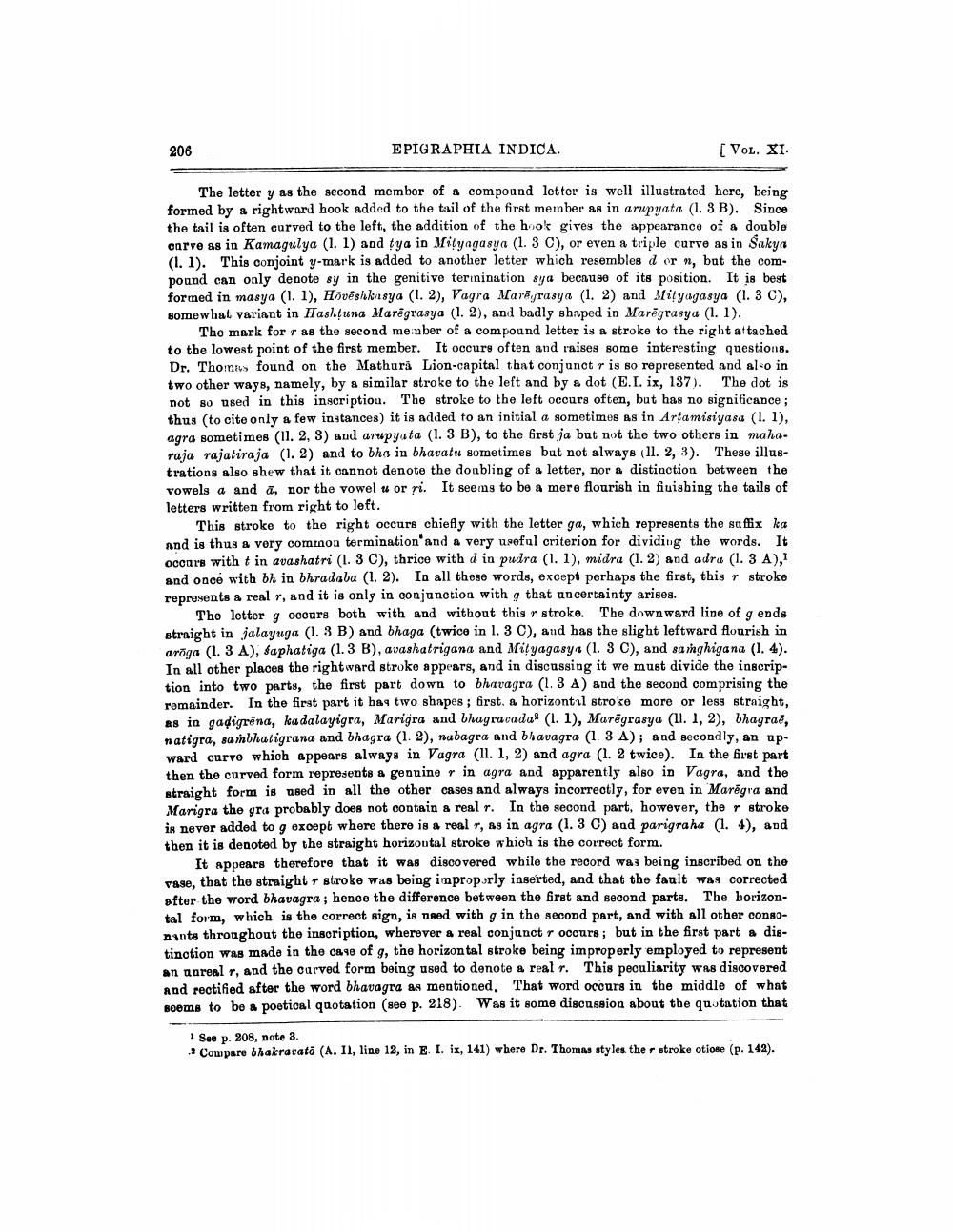________________
206
EPIGRAPHIA INDICA.
(VOL. XI.
The letter y as the second member of a compound letter is well illustrated here, being formed by a rightward hook added to the tail of the first member as in arupyata (1. 3 B). Since the tail is often curved to the left, the addition of the hook gives the appearance of a double carve as in Kamagulya (1.1) and tya in Mityagasya (1. 3 C), or even a triple curve as in Sakya (1.1). This conjoint y-mark is added to another letter which resembles d or n, but the compound can only denote sy in the genitive terinination sya because of its position. It is best formed in masya (1. 1), Hovëshkasya (1.2), Vagra Marēgrasya (1. 2) and Mityagasya (1. 3 C), somewhat variant in Hashtuna Marēgrasya (1.2), and badly shaped in Marēgrasya (1.1).
The mark for r as the second member of a compound letter is a stroke to the right attached to the lowest point of the first member. It occurs often and raises some interesting questions. Dr. Thomas found on the Mathuri Lion-capital that conjunct r is so represented and alco in two other ways, namely, by a similar stroke to the left and by a dot (E.I. ix, 137). The dot is not so used in this inscription. The stroke to the left occurs often, but has no significance ; thus (to cite only a few instances) it is added to an initial a sometimes as in Artamisiyasa (1.1), agra sometimes (11. 2, 3) and arupyata (1. 3 B), to the first ja but not the two others in maharaja rajatiraja (1.2) and to bhs in bharath sometimes but not always (11. 2, 3). These illustrations also shew that it cannot denote the doubling of a letter, nor a distinction between the vowels a and a, nor the vowel u or si. It seems to be a mere flourish in fiuisbing the tails of letters written from right to left.
This stroke to the right occurs chiefly with the letter ga, which represents the suffix ka and is thus a very commoa termination'and a very useful criterion for dividing the words. It occars with t in avashatri (1. 3 C), thrice with d in pudra (1.1), midra (1.2) and adru (1. 3 A), and once with bh in bhradaba (1.2). In all these words, except perhaps the first, this r stroke represents a real r, and it is only in conjunction with g that uncertainty arises.
The letter gooours both with and without this r stroke. The downward line of g ends straight in jalayuga (1. 3 B) and bhaga (twice in l. 3 C), and has the slight leftward flourish in aroga (1. 3 A), saphatiga (1.3 B), avashatrigana and Mityagasya (1. 3 C), and sanghigana (1.4). In all other places the right ward stroke appears, and in discussing it we must divide the inscription into two parts, the first part down to bhavagra (1. 3 A) and the second comprising the remainder. In the first part it hag two shapes; first. & horizontal stroke more or less straight, as in gadigrēna, kadalayigra, Marigra and bhagravada? (1.1), Marēgrasya (II. 1, 2), bhagraē, natigra, sambhatigrana and bhagra (1.2), nabagra and bhavagra (1. 3 A); and secondly, an upward curve which appears always in Vagra (1l. 1, 2) and agra (1. 2 twice). In the first part then the curved form represents a genuine in agra and apparently also in Vagra, and the straight form is used in all the other cases and always incorrectly, for even in Marēgra and Marigra the gra probably does not contain a real r. In the second part, however, the r stroke is never added to g except where there is a real T, as in agra (1. 3 C) and parigraha (1.4), and then it is denoted by the straight horizoutal stroke which is the correct form.
It appears therefore that it was discovered while the record was being inscribed on the vase, that the straight r stroke was being impropərly inserted, and that the fault was corrected after the word bhavagra; hence the difference between the first and second parts. The horizontal form, which is the correct sign, is used with g in the second part, and with all other congonants throughout the inscription, wherever a real conjunct r occurs; but in the first part a distinction was made in the case of g, the horizontal stroke being improperly employed to represent an aurealr, and the curved form being used to denote a real r. This peculiarity was discovered and rectified after the word bhavagra as mentioned. That word ocours in the middle of what Boems to be a poetical quotation (see p. 218). Was it some discussion about the quotation that
See p. 208, note 3. - Compare bhakrarati (A. II, line 12, in E. I. ix, 141) where Dr. Thomas styles ther stroke otiose (p. 142).




